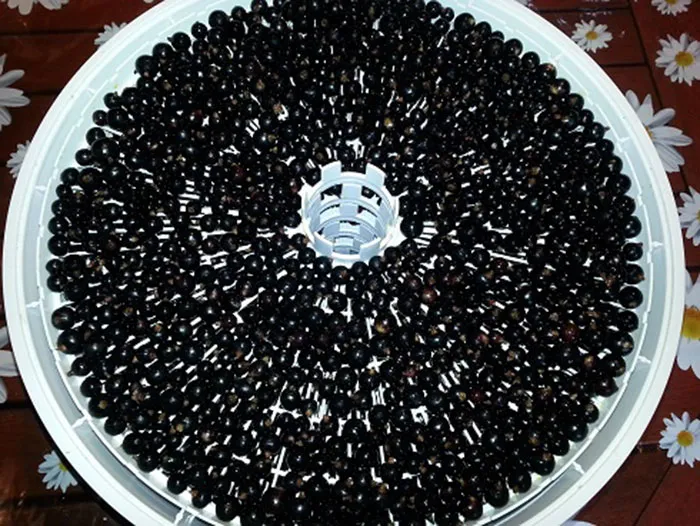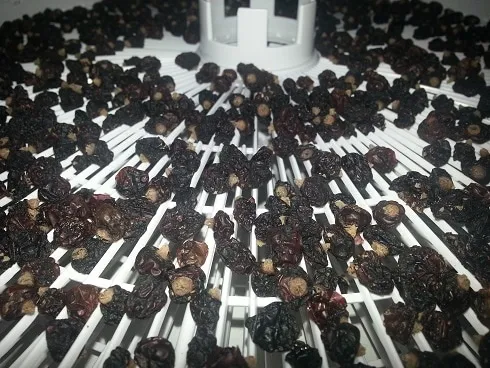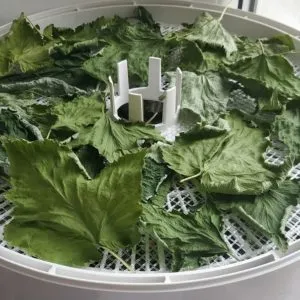One of the simplest ways to preserve blackcurrants for winter is drying. If the climate doesn’t allow sun-drying, an electric dehydrator can be used. Dried berries lose about 80% of their original mass and volume, but retain up to 70-80% of their nutrients, including sugars. Here’s how to dry blackcurrants in an electric dehydrator.
Table of contents
Can You Dry Blackcurrants in an Electric Dehydrator?
During canning, most beneficial compounds in berries and fruits are destroyed due to heat treatment. This is particularly noticeable when preserving vitamin-rich berries like blackcurrants.
Canning isn’t the only method for long-term storage. Drying is gentler on berries than boiling, allowing more nutrients and vitamins to remain intact.
Drying in an electric dehydrator is a lengthy process, but it offers significant advantages over other preservation methods.

Advantages and Disadvantages
Key advantages of drying berries:
- Dried berries retain nearly all their beneficial compounds.
- Dried blackcurrants shrink significantly, requiring less storage space—especially when ground into powder using a blender.
- Extended shelf life.
- Dried currants are ready to eat immediately.
Disadvantages of this method:
- Requires purchasing an electric dehydrator.
- The process is time-consuming.
- Slight changes in flavor may occur.
- Strict storage rules must be followed, as cold, heat, and humidity promote mold and microbial growth.
Some also consider the higher caloric content of dried fruit a drawback. 100g of dried blackcurrants contains five times more calories than fresh berries, as water evaporates during drying while sugars remain concentrated.
Proper Harvesting and Preparation
Blackcurrants ripen by mid-July, when they become widely available. When selecting berries for drying, ensure they are dry, clean, and undamaged.
If picking from your own garden, harvest on a sunny, dry morning or evening. Sort the berries carefully—only fully ripe, medium-sized ones should be dried. The rest can be used for jams or compotes.
Avoid drying dirty berries, as they won’t store well. Preparation steps:
- Gently rinse under running water in small batches using a colander.
- Remove stems, leaves, and debris.
- Spread on a cloth to dry completely. Even slight moisture can cause spoilage, so space them out in a single layer.
How to Dry Blackcurrants in an Electric Dehydrator
The process is straightforward. Prepare clean containers, jars with lids, or paper bags for storage beforehand.
Line the dehydrator trays with parchment paper to prevent berries from shrinking and falling through the mesh.
Arrange the blackcurrants in a single layer on the trays, ensuring they aren’t overcrowded for even drying.
Temperature and Drying Time
Set the dehydrator to 60–65°C (140–149°F). Drying takes at least 50 hours, with overnight breaks.
Note: Rotate trays periodically (for multi-tier dehydrators) to ensure uniform drying.
Safety Precautions
Dehydrator safety tips:
- Place the device on a heat-resistant surface, such as a thick cutting board or ceramic tile.
- Keep at least 10 cm (4 inches) from walls.
- Avoid continuous operation beyond 15 hours—allow a 2-hour cooldown.
- Ensure the power cord doesn’t touch hot surfaces or dangle off tables.
- Operate only on a flat, stable surface.
- Never cover the dehydrator while in use.
- Unplug after use.
- Do not leave unattended.
- Avoid handling with wet hands.
Checking for Doneness
Properly dried blackcurrants appear wrinkled, dark with a reddish hue, and emit a subtle aroma. Cool before transferring to paper bags, airtight containers, or zip-lock bags. Store in a dry place.

Variations for Black, Red, and White Currants
The drying process is identical for red and white currants.
Uses for Dried Berries
Dried blackcurrants serve as a winter vitamin source for teas, compotes, and jellies. They’re also used in liqueurs and infusions.
Rehydrate by soaking in water for a few hours to use in desserts, pastries, or as garnishes. Adjust quantities in recipes, as dried berries are more calorie-dense.
They enhance pancakes, puddings, cheesecakes, and even savory dishes like pilaf.
Storage Conditions and Shelf Life
Dried blackcurrants last up to 24 months when stored correctly. Keep at temperatures below 20°C (68°F) and humidity under 70%. A well-ventilated area like a hallway is ideal.
For fridge storage, use glass jars or zip-lock bags in the vegetable compartment.
Avoid metal containers—they impart a metallic taste within weeks. Cardboard boxes work if sealed tightly.
Note: Cool berries to room temperature before storage to prevent condensation and mold.
Drying Blackcurrant Leaves

Blackcurrant leaves are also prized for tea. The resulting brew is aromatic and offers health benefits, including cold relief and vitamin supplementation.
Note: Avoid this tea if you have high stomach acidity or ulcers.
Harvest leaves on dry mornings or evenings, selecting mid-branch foliage. Drying steps:
- Spread leaves thinly on trays.
- Preheat the dehydrator to 100°C (212°F) for 10 minutes.
- Dry leaves for 1.5 hours, then reduce temperature to 50°C (122°F) until fully dry.
Monitor closely to prevent over-drying or browning, which degrades quality.
Conclusion
Blackcurrants are among the most nutritious berries. Though their season is brief, drying preserves their vitamins year-round. This simple process outperforms canning in nutrient retention, making it an excellent choice for home preservation.







